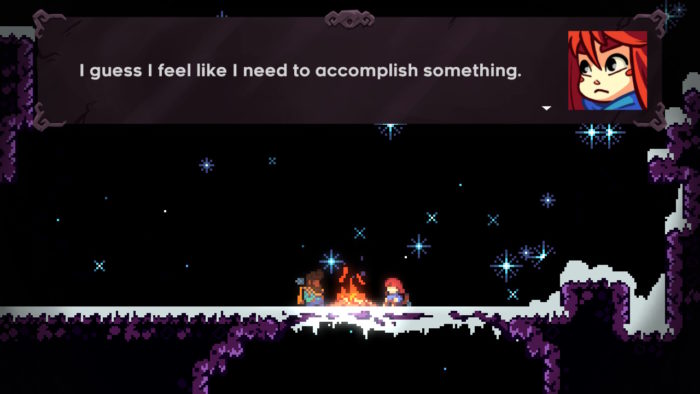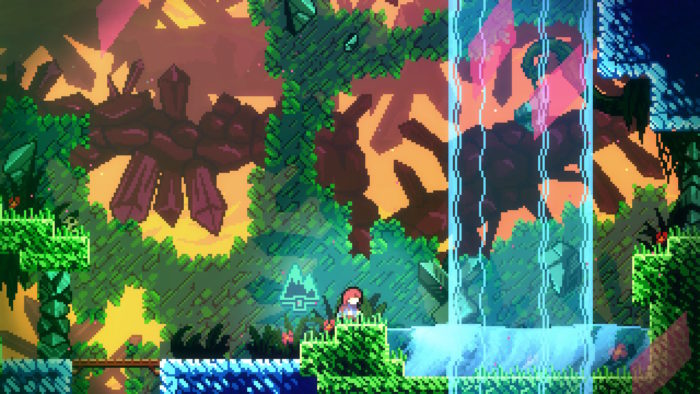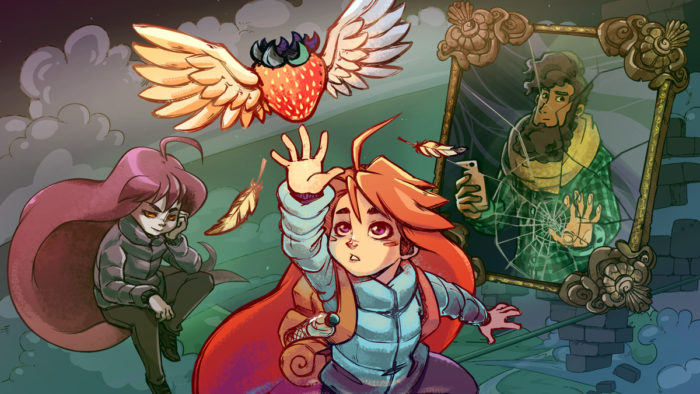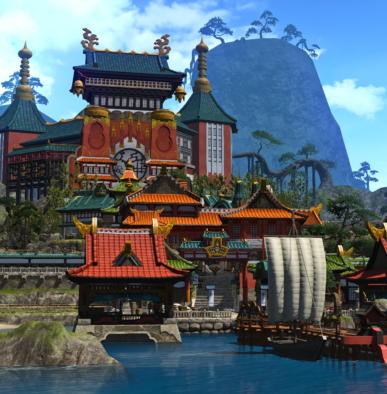2,649. That’s how many times I’ve died while playing through Celeste’s main story chapters. I realize it might look a bit extreme, dying that many times in a six to seven hour-long video game, but it’s a number I’m particularly proud of.
Some background info here, before we begin: I’d never even heard of Celeste before reviews started pouring out at the end of January. I’d seen it get promoted on the PlayStation Twitter account from time to time, maybe, but it wasn’t until the game started receiving such overwhelmingly positive critical reception that I started to look into it. Celeste is being cited as the warmest and most welcoming hardcore platformer game that we’ve ever seen, and for the most part, that’s true. As someone who gets easily frustrated with difficult games and doesn’t even like platformers, I thought I’d give it a go. At worst, if I didn’t like it, I could just set it aside and shrug it off as a game that wasn’t my cup of tea. But a strange thing happened, and I found myself unable to put it down. So then, here’s our official review of Celeste.
Celeste’s premise is simple. Players take control of a young girl named Madeline as she begins her journey to try to climb to the summit of the mysterious Celeste mountain. At the base, she meets a cynical old woman who tells her the path is fraught with dangers, and she’d never make it to the top. The characters of Celeste speak garbled gibberish, but their inflections often give you a good idea of their tone. As the old lady continued berating Madeline, it was easy to feel her snark even from the nonsensical sounds she was spouting at us.
Right from the get-go, it’s obvious there’s something not quite right with the mountain. And I’m not talking about the gravity-defying icicles and deadly spikes deliberately placed in unfortunate locations by the developers to increase the challenge. The mountain is doing something to Madeline. As she continues to make progress, she soon finds herself being haunted by an evil-looking girl who looks an awful lot like her. The girl is another part of Madeline, according to her, and it becomes clear that Madeline’s climbing this mountain to run from something. Or maybe she’s feeling like she has something to prove.

Celeste is awfully calming and relaxing for a hardcore platformer that demands precision and your full attention. The game tells you to breathe, it tells you that you can do this, and there’s nothing to fear. It’s a bit of a meta thing, as if the developers are trying to ease the player into the game. Take your time with the challenging levels, keep working at it, and eventually something will click and it’ll all fall into place. And if you find yourself unable to surpass these challenges, Celeste offers a rather newbie-friendly Assist Mode as well. Assist Mode offers players a variety of ways to tailor the game to their liking. From game speed to i-frames and the number of dashes you can do, Celeste is extremely accessible for players who may not be that skilled at platformers, like yours truly.
Tempting, though, as the Assist Mode was, I found myself stubbornly trying to power through the game ‘as intended.’ Things were rough, and I was on the verge of dropping the game until I completed the next chapter. Up until this point, the game suggests that Madeline is dealing with some serious internal issues. She suffers from depression and anxiety, and experiences frequent panic attacks. As welcoming as Celeste sets itself up to be, it also provides a rather apt depiction of what it’s like to suffer emotionally. Panic attacks are depicted as dark tendrils reaching up to you and threatening to pull you down below. A character’s insecurities are portrayed as dark blobs popping out of their body that serve as level obstacles to keep you away from them.
But Celeste also knows how to calm you down. The game literally teaches you to breathe slowly, all while picturing a feather floating slowly in the air to drive away the anxiety. It became easier to face the rest of Celeste’s platforming challenges from then on.
The game’s platforming is brutal, and Madeline dies from just one hit. Mistime an air dash, or fail to grab a wall, and it’s instant death for you. Thankfully, the checkpoints are quite merciful, and the respawn time is immediate so you’re never left hanging for too long. The levels are intricately designed, and they’re all meant to teach the game’s basic mechanics and impart new platforming techniques to the player. The controls are tight and very precise, which means that every death is on you, not the game. The world design and 2D pixel art is charming as well, with a varied color palette to distinguish the different levels. All of these elements come together to lend the game a rather saccharine quality in some areas, though Celeste isn’t afraid to get eerie and foreboding in others.
Most chapters will end with a boss fight, though these are more like puzzle levels where you have to figure out the most efficient route across the screen while dodging projectile attacks. The boss fights are the true highlight of the game, and they’re frantic chase sequences that really test your skills and reflexes. Expect to die frequently during these fights. It’s a good thing the chiptune music is so wonderful in Celeste – you’ll be hearing a lot of the tunes for each level.

Unfortunately, Celeste does suffer from some questionable gameplay design choices as well. The most egregious of which is a wind mechanic in a particular level that greatly impedes your movement. The wind blowing one way or the other can slow you down significantly or make you lose control of your jumps. This is where deaths can start to feel a little cheap, and it’s more tedious than challenging.
Still, at some point, I realized I was starting to (gasp) actually have fun despite dying over and over. The final chapter in the main story gives you a seriously cathartic sense of progression. After struggling through a multitude of challenges, Celeste presents you with one last level that forces you to show off just what you’ve learned in the last six hours.
After you complete the main story, there’s even more content available in Celeste if you want it. There’s a bonus level that gives you a bit more closure to the story, there are tons of collectibles in each stage that you can go back to try to collect, and there are B-sides, which are essentially harder versions of the levels you’ve already cleared. I’ve also heard that there are C-sides, which are even more extreme than B-sides, if that were possible.
Hands shaking, I finally reached the summit, and that gave me a sense of accomplishment like no other. It was as if Madeline and I had conquered a challenge that previously seemed insurmountable – her trying to make peace with her demons, and me trying to push myself out of my gaming comfort zone by beating a precision platformer with no handicaps. Sure, her journey was a lot more meaningful than mine, but we both felt a sense of relief and pride upon arriving at the top of the mountain. All throughout the journey, the game has you believe that if you can conquer the mountain, if you can beat Celeste, well, you can do anything. And even if you don’t, the game tells you it’s okay. What matters is that you tried.
Looking at my death count at the end of the game, it was a little shocking to see that I’d died that many times. But Celeste constantly reassures the player that it’s not something to be ashamed of. Every death is a lesson learned, and with every lesson comes improvement. As long as you don’t give up, there’s always a path to success. Even if you have to fail 2,649 times to see it.


There are no comments.